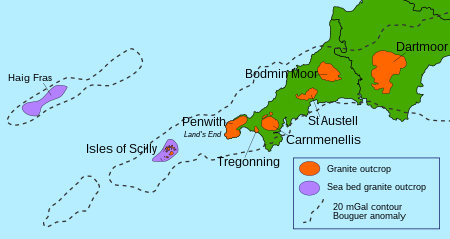
The Cornubian batholith is a large mass of granite rock, formed about 280 million years ago, which lies beneath much of Cornwall and Devon in the south-western peninsula of Great Britain. The main exposed masses of granite are seen at Dartmoor, Bodmin Moor, St Austell, Carnmenellis, Land's End and the Isles of Scilly. The intrusion is associated with significant quantities of minerals particularly cassiterite, an ore of tin which has been mined since about 2000 BC. Other minerals include china clay and ores of copper, lead, zinc and tungsten.
It takes its name from Cornubia, the Medieval Latin name for Cornwall.
© MMXXIII Rich X Search. We shall prevail. All rights reserved. Rich X Search
